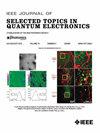集成二维MoS2薄膜的硅光子波导偏振器
IF 5.1
2区 工程技术
Q1 ENGINEERING, ELECTRICAL & ELECTRONIC
IEEE Journal of Selected Topics in Quantum Electronics
Pub Date : 2025-09-16
DOI:10.1109/JSTQE.2025.3610438
引用次数: 0
摘要
偏振控制对现代光学系统至关重要,而光学偏振器是实现这一功能的关键部件。在这里,我们通过将二维二硫化钼(MoS2)薄膜集成到硅光子波导上,实验证明了光学偏振器。采用低压化学气相沉积(LPCVD)方法合成了具有高各向异性光吸收的高质量MoS2单层薄膜,并将其转移到绝缘体上硅(SOI)纳米线波导上以制造集成光学偏振器。对不同MoS2薄膜涂层长度和硅波导几何形状的器件进行了详细的测量。结果表明,极化相关的最大损耗达到了~ 21 dB,同时具有~ 4.2的高品质值。此外,混合波导偏振器具有超过~ 100 nm的宽工作带宽和优异的功率耐久性。这些结果突出了2D MoS2薄膜片上集成实现高性能极化选择器件的强大潜力。本文章由计算机程序翻译,如有差异,请以英文原文为准。
Silicon Photonic Waveguide Polarizers Integrated With 2D MoS2 Films
Polarization control is of fundamental importance for modern optical systems, and optical polarizers serve as critical components for enabling this functionality. Here, we experimentally demonstrate optical polarizers by integrating 2D molybdenum disulfide (MoS2) films onto silicon photonic waveguides. High-quality monolayer MoS2 films with highly anisotropic light absorption are synthesized via a low-pressure chemical vapor deposition (LPCVD) method and subsequently transferred onto silicon-on-insulator (SOI) nanowire waveguides to fabricate integrated optical polarizers. Detailed measurements are carried out for the fabricated devices with various MoS2 film coating lengths and silicon waveguide geometry. The results show that a maximum polarization-dependent loss of ∼21 dB is achieved, together with a high figure of merit of ∼4.2. In addition, the hybrid waveguide polarizers exhibit broad operation bandwidth exceeding ∼100 nm and excellent power durability. These results highlight the strong potential for on-chip integration of 2D MoS2 films to implement high-performance polarization selective devices.
求助全文
通过发布文献求助,成功后即可免费获取论文全文。
去求助
来源期刊

IEEE Journal of Selected Topics in Quantum Electronics
工程技术-工程:电子与电气
CiteScore
10.60
自引率
2.00%
发文量
212
审稿时长
3 months
期刊介绍:
Papers published in the IEEE Journal of Selected Topics in Quantum Electronics fall within the broad field of science and technology of quantum electronics of a device, subsystem, or system-oriented nature. Each issue is devoted to a specific topic within this broad spectrum. Announcements of the topical areas planned for future issues, along with deadlines for receipt of manuscripts, are published in this Journal and in the IEEE Journal of Quantum Electronics. Generally, the scope of manuscripts appropriate to this Journal is the same as that for the IEEE Journal of Quantum Electronics. Manuscripts are published that report original theoretical and/or experimental research results that advance the scientific and technological base of quantum electronics devices, systems, or applications. The Journal is dedicated toward publishing research results that advance the state of the art or add to the understanding of the generation, amplification, modulation, detection, waveguiding, or propagation characteristics of coherent electromagnetic radiation having sub-millimeter and shorter wavelengths. In order to be suitable for publication in this Journal, the content of manuscripts concerned with subject-related research must have a potential impact on advancing the technological base of quantum electronic devices, systems, and/or applications. Potential authors of subject-related research have the responsibility of pointing out this potential impact. System-oriented manuscripts must be concerned with systems that perform a function previously unavailable or that outperform previously established systems that did not use quantum electronic components or concepts. Tutorial and review papers are by invitation only.
 求助内容:
求助内容: 应助结果提醒方式:
应助结果提醒方式:


